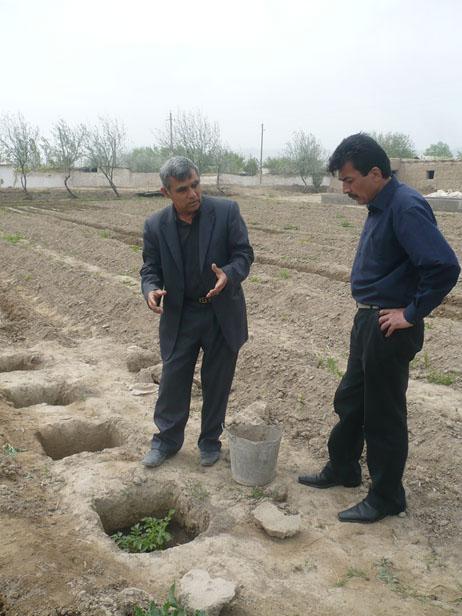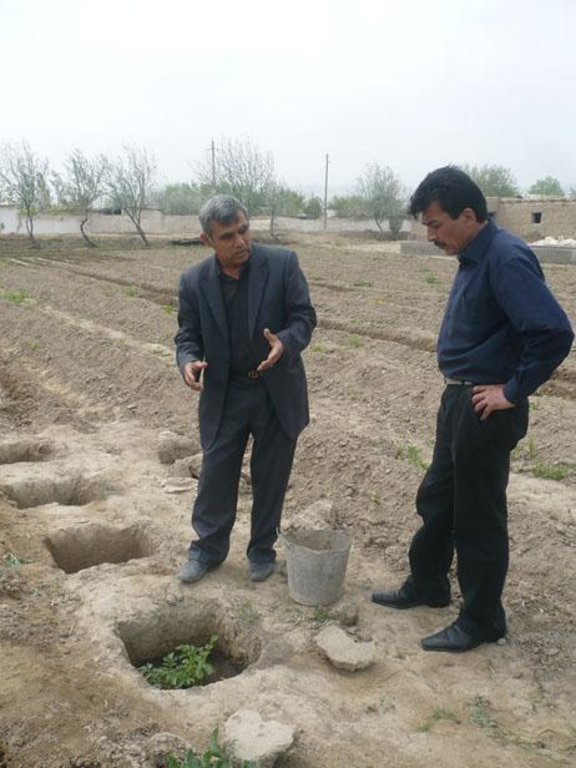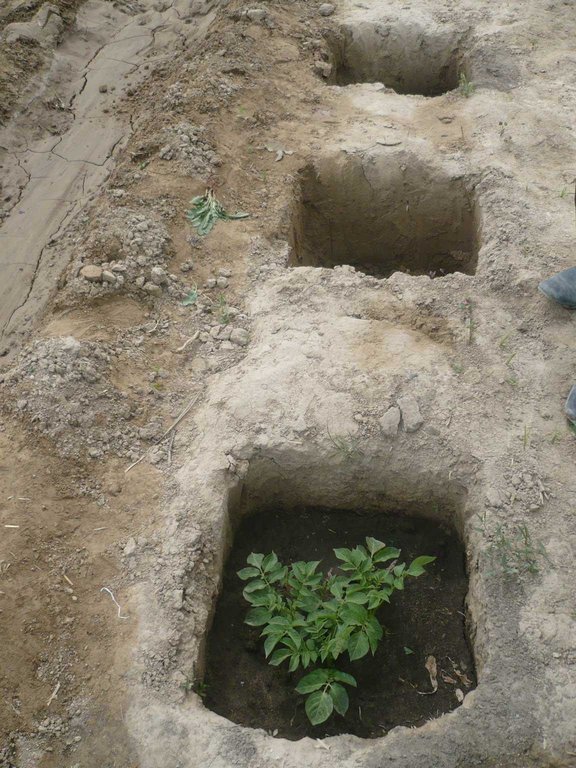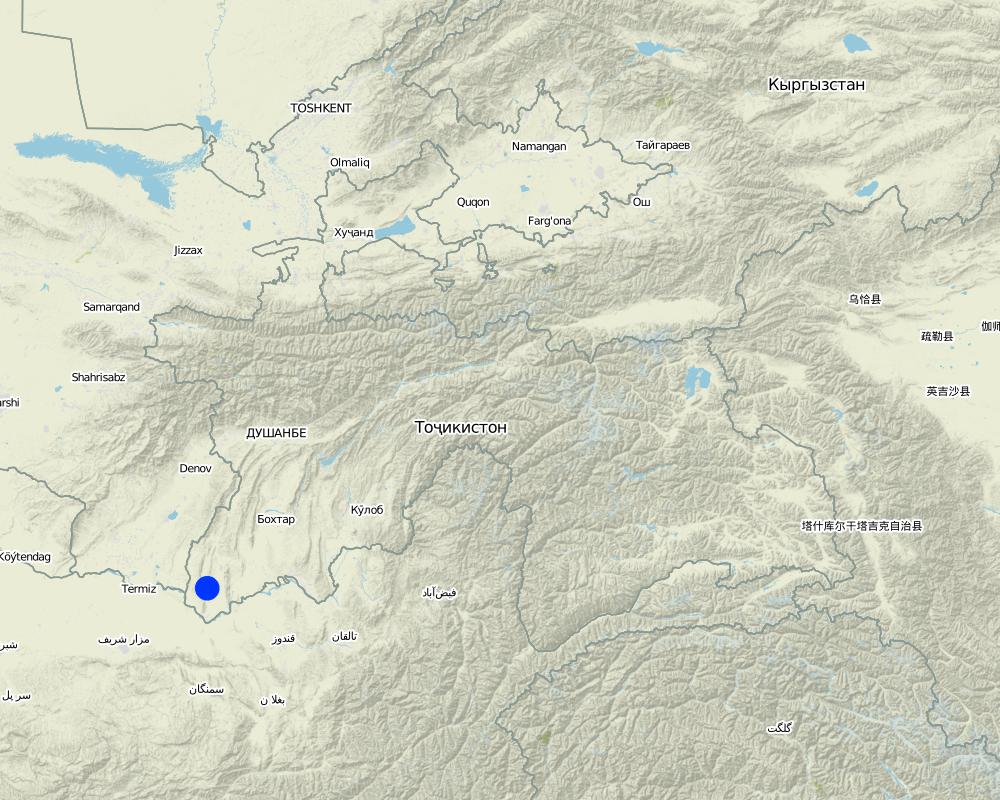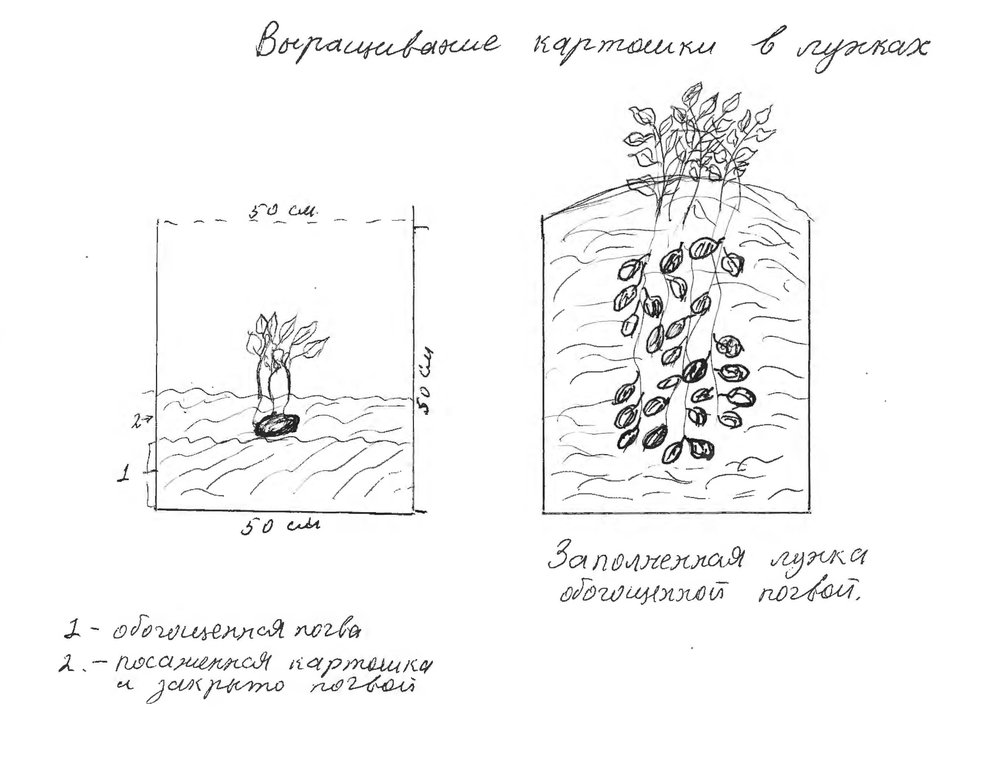Vertical growing of potatoes in pits, by the gradual addition of further layers of soil. [Tajikistan]
- Creation:
- Update:
- Compiler: Rustam Kalandarov
- Editor: –
- Reviewers: David Streiff, Alexandra Gavilano
technologies_1038 - Tajikistan
- Full summary as PDF
- Full summary as PDF for print
- Full summary in the browser
- Full summary (unformatted)
- Vertical growing of potatoes in pits, by the gradual addition of further layers of soil.: March 20, 2017 (inactive)
- Vertical growing of potatoes in pits, by the gradual addition of further layers of soil.: July 22, 2017 (inactive)
- Vertical growing of potatoes in pits, by the gradual addition of further layers of soil.: Aug. 19, 2019 (inactive)
- Vertical growing of potatoes in pits, by the gradual addition of further layers of soil.: Nov. 2, 2021 (public)
View sections
Expand all Collapse all1. General information
1.2 Contact details of resource persons and institutions involved in the assessment and documentation of the Technology
SLM specialist:
Name of the institution(s) which facilitated the documentation/ evaluation of the Technology (if relevant)
Youth Ecological Center, Tajikistan (Youth Ecological Center, Tajikistan) - TajikistanName of the institution(s) which facilitated the documentation/ evaluation of the Technology (if relevant)
NCCR North-South (NCCR North-South) - Kyrgyzstan1.3 Conditions regarding the use of data documented through WOCAT
The compiler and key resource person(s) accept the conditions regarding the use of data documented through WOCAT:
Yes
2. Description of the SLM Technology
2.1 Short description of the Technology
Definition of the Technology:
Vertical growing of potatoes in pits, by the gradual addition of further layers of soil.
2.2 Detailed description of the Technology
Description:
The technology is used in areas that have extreme climatic conditions and a high water deficit. The technology is quite simple; compost or enriched soil is placed into the bottom of a 50x50x50cm pit. Then, one or two potatoes are planted into the base of the pit, and covered with soil. As the potato grows, the pit is gradually filled up with soil to keep it covered. It is also watered regulary.
Purpose of the Technology: The purpose of this technology is to improve the potato yield, and therefore to increase farm income under these climatic conditions. The technology is well adapted to this arid area with only a little irrigation water available, because the method improves access to water.
Establishment / maintenance activities and inputs: The technology is quite simple and not cost intensive. Costs are mainly connected to the purchase of high-quality seeds and compost production. Labour is needed to dig the pits, and fill and maintain them.
Natural / human environment: The technology can be used under any agricultural conditions, such as on Dehkan farms as well as in kitchen gardens
2.3 Photos of the Technology
2.5 Country/ region/ locations where the Technology has been applied and which are covered by this assessment
Country:
Tajikistan
Region/ State/ Province:
Tajikistan
Further specification of location:
Khatlon District, Nosiri Husrav region
Specify the spread of the Technology:
- evenly spread over an area
If precise area is not known, indicate approximate area covered:
- < 0.1 km2 (10 ha)
Comments:
Total area covered by the SLM Technology is 1ha km2.
Map
×3. Classification of the SLM Technology
3.1 Main purpose(s) of the Technology
- improve production
3.2 Current land use type(s) where the Technology is applied

Cropland
- Annual cropping
Annual cropping - Specify crops:
- root/tuber crops - potatoes
Number of growing seasons per year:
- 2
Specify:
Longest growing period in days: 150Longest growing period from month to month: January - MaySecond longest growing period in days: 180Second longest growing period from month to month: June - November
Comments:
Major land use problems (compiler’s opinion): The main problem is connected with optimum use of land
3.4 Water supply
Water supply for the land on which the Technology is applied:
- full irrigation
3.5 SLM group to which the Technology belongs
- irrigation management (incl. water supply, drainage)
3.6 SLM measures comprising the Technology

agronomic measures
- A2: Organic matter/ soil fertility
- A6: Residue management
Comments:
Main measures: agronomic measures
Type of agronomic measures: relay cropping, mulching, manure / compost / residues, furrows (drainage, irrigation)
3.7 Main types of land degradation addressed by the Technology

chemical soil deterioration
- Cn: fertility decline and reduced organic matter content (not caused by erosion)

physical soil deterioration
- Pk: slaking and crusting
- Pi: soil sealing
Comments:
Main type of degradation addressed: Cn: fertility decline and reduced organic matter content, Pk: sealing and crusting
Main causes of degradation: crop management (annual, perennial, tree/shrub), land tenure
Secondary causes of degradation: soil management, change in temperature, change of seasonal rainfall, droughts, poverty / wealth
3.8 Prevention, reduction, or restoration of land degradation
Specify the goal of the Technology with regard to land degradation:
- prevent land degradation
- reduce land degradation
Comments:
Основная цель: предотвращение / сокращение деградации, предупреждение деградации земель
4. Technical specifications, implementation activities, inputs, and costs
4.1 Technical drawing of the Technology
Technical specifications (related to technical drawing):
A drawing showing the pit's lower part, which is filled with compost and rich soil as the potato grows.
Location: South of Tajikistan. Husrav, Khatlon
Date: 11.05.2011
Technical knowledge required for land users: moderate
Main technical functions: improvement of surface structure (crusting, sealing)
Relay cropping
Material/ species: potato seeds
Remarks: digging pits
Manure / compost / residues
Author:
Kalandarov R., Dushanbe, 3 Herzin street
4.2 General information regarding the calculation of inputs and costs
Specify currency used for cost calculations:
- USD
other/ national currency (specify):
450
Indicate average wage cost of hired labour per day:
5
4.3 Establishment activities
| Activity | Timing (season) | |
|---|---|---|
| 1. | Digging holes |
4.4 Costs and inputs needed for establishment
| Specify input | Unit | Quantity | Costs per Unit | Total costs per input | % of costs borne by land users | |
|---|---|---|---|---|---|---|
| Labour | Digging holes | ha | 1.0 | 8.0 | 8.0 | 100.0 |
| Equipment | Tools | pieces | 1.0 | 5.0 | 5.0 | 100.0 |
| Plant material | Seeds | kg | 200.0 | 0.45 | 90.0 | 1.0 |
| Total costs for establishment of the Technology | 103.0 | |||||
| Total costs for establishment of the Technology in USD | 103.0 | |||||
4.5 Maintenance/ recurrent activities
| Activity | Timing/ frequency | |
|---|---|---|
| 1. | Filling pits with soil | человек ден |
| 2. | заполнение лунок почвой | человек/день |
4.6 Costs and inputs needed for maintenance/ recurrent activities (per year)
| Specify input | Unit | Quantity | Costs per Unit | Total costs per input | % of costs borne by land users | |
|---|---|---|---|---|---|---|
| Labour | Filling pits with soil | Persons/day | 0.1 | 5.0 | 0.5 | 100.0 |
| Total costs for maintenance of the Technology | 0.5 | |||||
| Total costs for maintenance of the Technology in USD | 0.5 | |||||
4.7 Most important factors affecting the costs
Describe the most determinate factors affecting the costs:
Digging the pits is the most determinate factor as it requires a lot of labour.
5. Natural and human environment
5.1 Climate
Annual rainfall
- < 250 mm
- 251-500 mm
- 501-750 mm
- 751-1,000 mm
- 1,001-1,500 mm
- 1,501-2,000 mm
- 2,001-3,000 mm
- 3,001-4,000 mm
- > 4,000 mm
Agro-climatic zone
- arid
Thermal climate class: subtropics
5.2 Topography
Slopes on average:
- flat (0-2%)
- gentle (3-5%)
- moderate (6-10%)
- rolling (11-15%)
- hilly (16-30%)
- steep (31-60%)
- very steep (>60%)
Landforms:
- plateau/plains
- ridges
- mountain slopes
- hill slopes
- footslopes
- valley floors
Altitudinal zone:
- 0-100 m a.s.l.
- 101-500 m a.s.l.
- 501-1,000 m a.s.l.
- 1,001-1,500 m a.s.l.
- 1,501-2,000 m a.s.l.
- 2,001-2,500 m a.s.l.
- 2,501-3,000 m a.s.l.
- 3,001-4,000 m a.s.l.
- > 4,000 m a.s.l.
5.3 Soils
Soil depth on average:
- very shallow (0-20 cm)
- shallow (21-50 cm)
- moderately deep (51-80 cm)
- deep (81-120 cm)
- very deep (> 120 cm)
Soil texture (topsoil):
- medium (loamy, silty)
Topsoil organic matter:
- low (<1%)
If available, attach full soil description or specify the available information, e.g. soil type, soil PH/ acidity, Cation Exchange Capacity, nitrogen, salinity etc.
Soil fertility is very low
Soil drainage / infiltration is medium
Soil water storage capacity is very low
5.4 Water availability and quality
Ground water table:
< 5 m
Availability of surface water:
medium
Water quality (untreated):
good drinking water
5.5 Biodiversity
Species diversity:
- medium
5.6 Characteristics of land users applying the Technology
Market orientation of production system:
- subsistence (self-supply)
- mixed (subsistence/ commercial)
Off-farm income:
- 10-50% of all income
Relative level of wealth:
- average
Individuals or groups:
- individual/ household
Level of mechanization:
- manual work
- animal traction
Gender:
- women
- men
Indicate other relevant characteristics of the land users:
Land users applying the Technology are mainly common / average land users
Population density: 10-50 persons/km2
Annual population growth: 0.5% - 1%
5.7 Average area of land used by land users applying the Technology
- < 0.5 ha
- 0.5-1 ha
- 1-2 ha
- 2-5 ha
- 5-15 ha
- 15-50 ha
- 50-100 ha
- 100-500 ha
- 500-1,000 ha
- 1,000-10,000 ha
- > 10,000 ha
Is this considered small-, medium- or large-scale (referring to local context)?
- medium-scale
5.8 Land ownership, land use rights, and water use rights
Land ownership:
- state
Water use rights:
- open access (unorganized)
5.9 Access to services and infrastructure
health:
- poor
- moderate
- good
education:
- poor
- moderate
- good
technical assistance:
- poor
- moderate
- good
employment (e.g. off-farm):
- poor
- moderate
- good
markets:
- poor
- moderate
- good
energy:
- poor
- moderate
- good
roads and transport:
- poor
- moderate
- good
drinking water and sanitation:
- poor
- moderate
- good
financial services:
- poor
- moderate
- good
6. Impacts and concluding statements
6.1 On-site impacts the Technology has shown
Socio-economic impacts
Production
crop production
Water availability and quality
demand for irrigation water
Socio-cultural impacts
food security/ self-sufficiency
Livelihood and human well-beeing
Ecological impacts
Water cycle/ runoff
surface runoff
Climate and disaster risk reduction
drought impacts
6.3 Exposure and sensitivity of the Technology to gradual climate change and climate-related extremes/ disasters (as perceived by land users)
Gradual climate change
Gradual climate change
| Season | increase or decrease | How does the Technology cope with it? | |
|---|---|---|---|
| annual temperature | increase | well |
Climate-related extremes (disasters)
Meteorological disasters
| How does the Technology cope with it? | |
|---|---|
| local rainstorm | not known |
| local windstorm | well |
Climatological disasters
| How does the Technology cope with it? | |
|---|---|
| drought | well |
Hydrological disasters
| How does the Technology cope with it? | |
|---|---|
| general (river) flood | not well |
Other climate-related consequences
Other climate-related consequences
| How does the Technology cope with it? | |
|---|---|
| reduced growing period | not known |
6.4 Cost-benefit analysis
How do the benefits compare with the establishment costs (from land users’ perspective)?
Short-term returns:
very positive
How do the benefits compare with the maintenance/ recurrent costs (from land users' perspective)?
Short-term returns:
very positive
6.5 Adoption of the Technology
If available, quantify (no. of households and/ or area covered):
NA
Comments:
Comments on spontaneous adoption: The technology is being gradually improved and developed
There is a little trend towards spontaneous adoption of the Technology
Comments on adoption trend: There has been some gradual adoption.
6.7 Strengths/ advantages/ opportunities of the Technology
| Strengths/ advantages/ opportunities in the compiler’s or other key resource person’s view |
|---|
| New agricultural technology |
|
Growing in pits promotes an increase in crop yield How can they be sustained / enhanced? Good yields are possible with the use of required agrotechnology |
|
Water saving technology How can they be sustained / enhanced? Individual irrigation |
|
The technology can be used on small land plots and is therefore well adapted for the use in kitchen gardens How can they be sustained / enhanced? The technology is able to provide one family with enough food for their use. |
6.8 Weaknesses/ disadvantages/ risks of the Technology and ways of overcoming them
| Weaknesses/ disadvantages/ risks in the land user’s view | How can they be overcome? |
|---|---|
| все что указано выше |
| Weaknesses/ disadvantages/ risks in the compiler’s or other key resource person’s view | How can they be overcome? |
|---|---|
| Technology is applicable to a small land area. | not taken into account due to specific characteristics of the technology |
| Problems during harvesting period |
7. References and links
7.1 Methods/ sources of information
Links and modules
Expand all Collapse allLinks
No links
Modules
No modules


